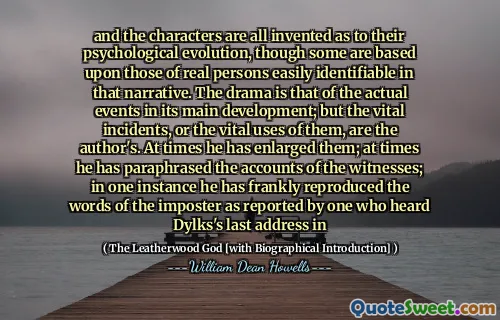
and the characters are all invented as to their psychological evolution, though some are based upon those of real persons easily identifiable in that narrative. The drama is that of the actual events in its main development; but the vital incidents, or the vital uses of them, are the author's. At times he has enlarged them; at times he has paraphrased the accounts of the witnesses; in one instance he has frankly reproduced the words of the imposter as reported by one who heard Dylks's last address in
This passage offers a fascinating exploration of the distinction between fact and fiction in storytelling. The author articulates a deliberate blending of reality and imagination, where characters are psychologically developed constructs inspired by real individuals, yet shaped to serve the narrative's needs. This method underscores the fluid boundaries between truth and creative embellishment, which is central to much literary and journalistic endeavors. By acknowledging that some characters are based on real persons, the author invites us to consider how real experiences and people can be reinterpreted through the lens of storytelling to serve thematic or dramatic purposes. The statement also emphasizes the importance of the actual events driving the plot, even as the details or 'vital incidents' are crafted or adjusted by the author. This conscious manipulation—enlarging, paraphrasing, or faithfully reproducing eyewitness accounts—demonstrates the extensive influence of the writer's perspective in shaping perception. It raises compelling questions about authenticity, memory, and the role of the author in constructing narratives that feel genuine yet are inherently subjective. The mention of reproducing words verbatim from witnesses highlights a respect for factual accuracy, while the acknowledgment of creative adaptations reflects the artistic license integral to storytelling. Overall, this passage underscores the delicate balance a writer must strike between truth and invention to craft a compelling, believable narrative that resonates with readers by blending factual basis with inventive enhancement.






